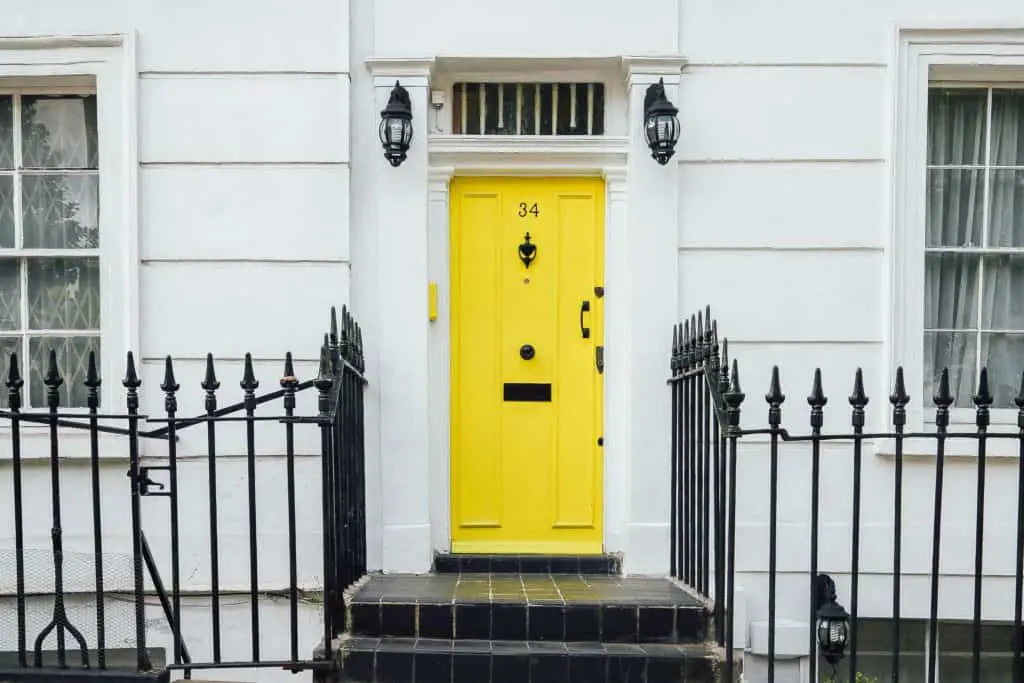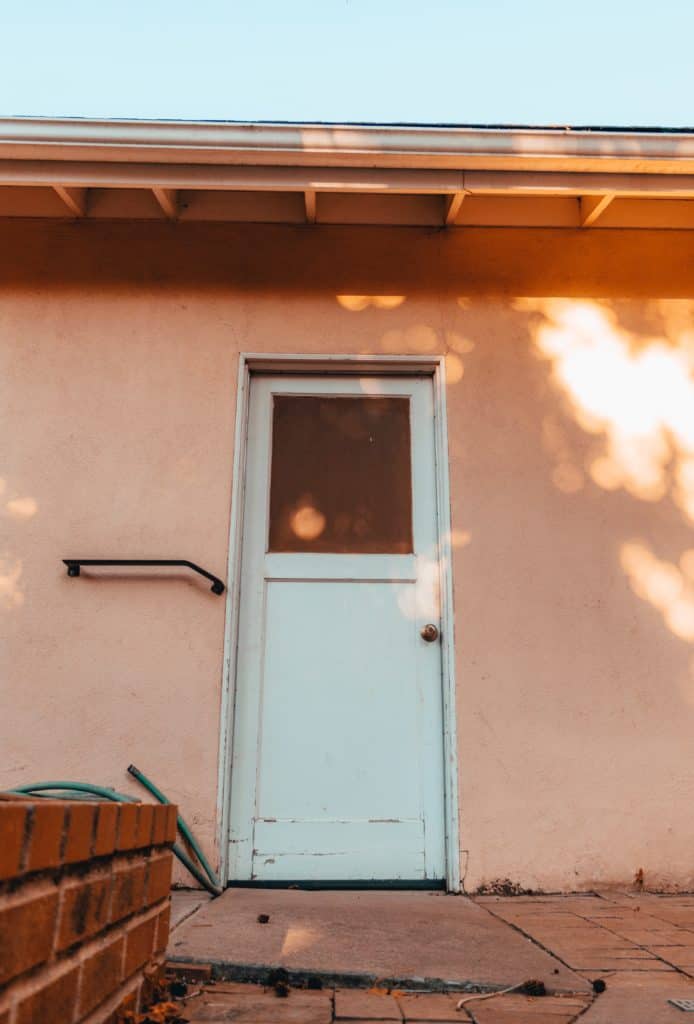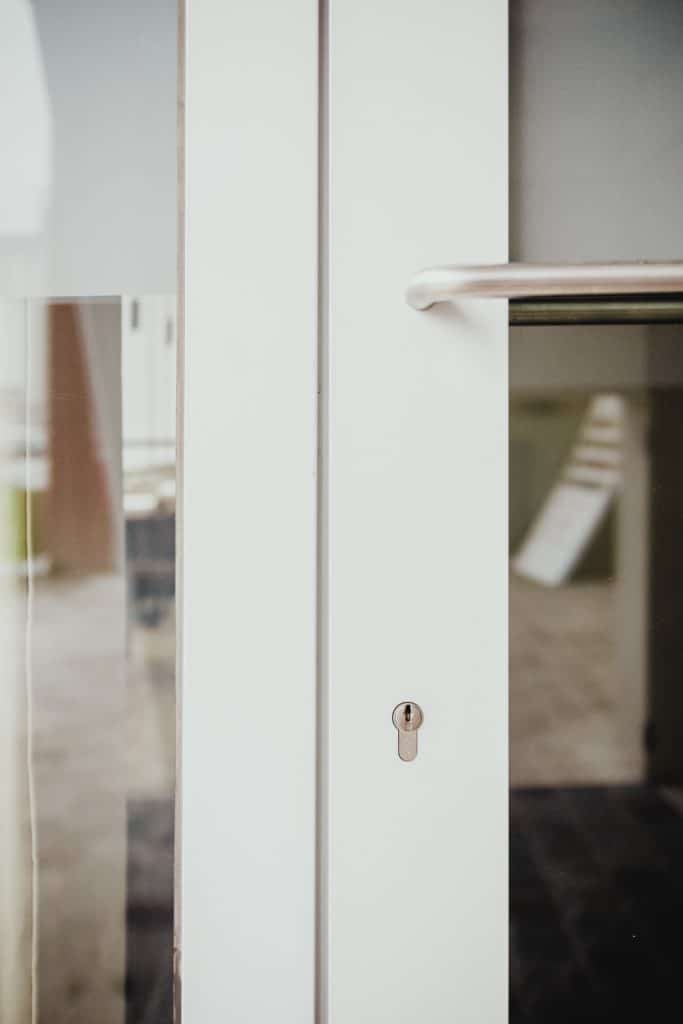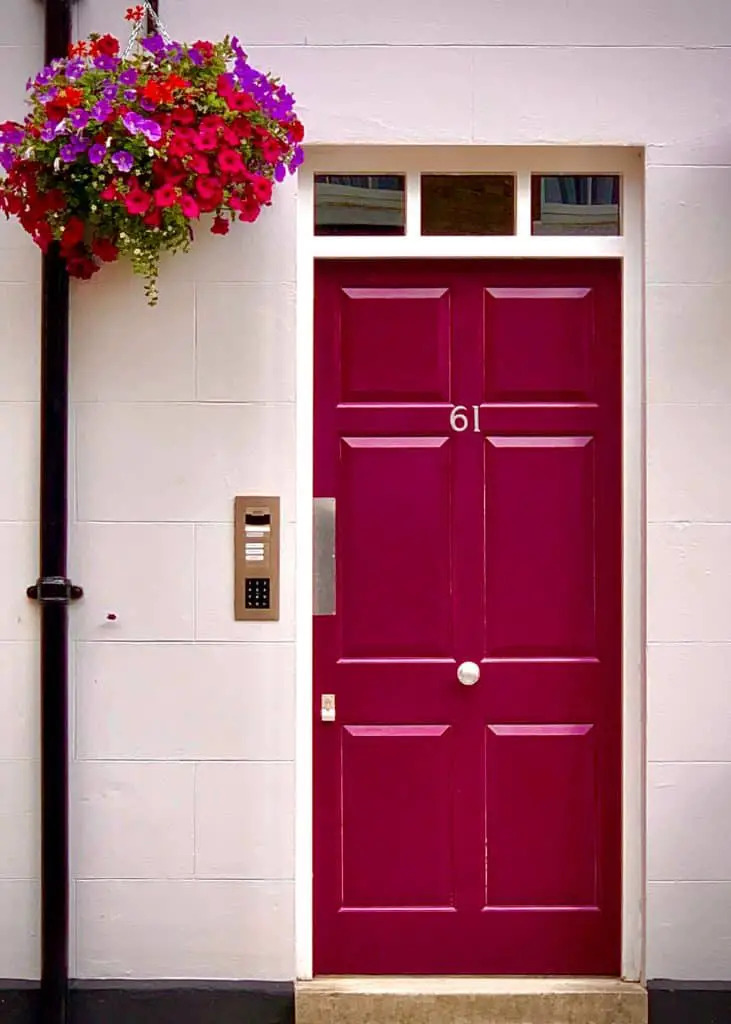Front doors are the first impression of any home. You may think that you need one, but the reality is you probably just want one. When my wife and I bought our home, we were looking at uPVC doors, but they were just too expensive for us. I wanted to know more, so I did a bit of research on different door options, safety, and refurbishment.
Is buying a new front door worth it? If your door has problems, e.g water damage, heavily weathered, or has cracks it may be worth replacing. Painting your door even if it is made from uPVC is a cost-effective way to make your door look better.
Front doors are really important barriers to the outside elements and unwanted strangers. It’s important to have a solid door and sturdy locks for your safety. The look and feel of your door is important too, especially when it comes to selling your place in the future. Replacing a door is not always the best option though. There’s some things you can look out for to assess if your door needs replacing.
How much does it cost to replace a front door?

The cost of a new uPVC front door can vary quite a lot. Prices can vary from 100s to 1000s of pounds depending on how fancy you want your door to be.
It’s worth buying a good quality door, and spending more if you are replacing your existing one. The main reason being as your front door is not something you’re going to be undertaking every year.
Companies can quote anything from 100s to thousands of pounds for your door and installation. Certain features of your door can affect the price massively. So before you invite your double glazing salesman over it’s probably worth being aware of the following factors that can affect a doors price.
What can affect the price of a uPVC door?

Before you buy the door with all of the bells and whistles on it, just bear in mind what’s going to add to your front door bill.
What can affect the price of a door
- The color of the door
- The amount and of glass
- Fixtures
- Efficiency
1. The color of the door
uPVC doors typically come in white color. Adding a specific color to a door can add up to 10% or 20% to the overall price tag.
That being said, the color of your door can add some serious curb appeal to your home. By that, we mean a factor that could help you sell your home in the future, so it may be a job worth doing. I’ve gone into more details on jobs worth doing when selling your house in my post here.
2. The amount and type of glass
Getting ordinary clear glass is by far the cheapest option when it comes to replacing your door. The less glass that you have, the cheaper it will be. I guess that goes without saying. As a general guide, below are decorative glass options you’ll probably get presented with when buying a door. The price will generally increase as you work your way through these options:
- Bars – glazing bars in rectangles between panes in your double glazing
- Beveled – bespoke design within the glass
- Etched – specific frosted with a design carved in it
- Obscure- textured feel to blur visibility through the glass
Just ask to see examples of all options available to you. Personally I prefer going to bars, mainly because they are simple but timeless. I mean this design doesn’t really go out of fashion. I’m less is more kind of guy, to be honest.
I’m not a big fan of plain glass, as I just think it’s overexposure to the outside world generally, but if you like that look, go for it. It should be cheaper.
3. Fixtures
The type of handle, knocker, letterbox and door brush for example are features that can increas the price. You might think that these are small points, but you can expect an extra few 100 pounds if you’re not careful.
If you want to save some money, you could get the basic fixtures, and source cheaper fixtures through websites such as ironmongerydirect.co.uk
4. Efficiency
uPVC doors have energy ratings believe it or not. The better the door insulates your home the higher the rating. The rating ranges from it’s highest and most efficient rating A++, to E the lowest and least efficient rating.
More efficient doors tend to be more expensive unsurprisingly
When should I replace my front door?

In order to tell if you need to take your front door out of its misery here are a few telltale signs that your door needs changing;
- It’s a struggle opening and closing the door
- There’s a draft coming in under your door when it is closed
- The door is beaten cracked or warped
- There’s moisture between the panes of glass
- The door is heavily dented
- Sticking or fault door lock mechanism
It’s a struggle opening and closing the door
Does your door stick in the winter and open easily in the summer? or visa versa depending on where you live.
This is a sign that you have energy escaping from your house in some way shape or form. It’s also a sign that you’ve got exposed areas around your door.
If you can see light through the edges of your door, that’s not a good sign either. It indicates leaking air, which again is not very energy efficient.
There’s a draft coming in under your door when it is closed
Do you sometimes put a towel under your door to stop the freezing air from coming in? That’s actually pretty clever of you. You’ve basically fixed your own issue.
If you’re looking for a more permanent fix you can of course replace your door, and it makes sense if you are experiencing any of other issues mentioned in this list.
If however, this is your only issue, it’s probably not worth replacing the entire door. You can fix the draft yourself by fitting a door brush, which is significantly cheaper.
The door is beaten, cracked or warped
Front doors can take a real beating over their lifetime. They are slammed open and shut, knocked regularly with shopping bags as well as bigger items and heavy furniture.
Your door also battles the elements everyday. If you have a wooden door, and it hasn’t been treated in a while it may have also become cracked warped due to the moisture damage over time.
In this instance, trying to revive a door like this may not be the best use of your time. Because the door is fundamentally damaged, it’s probably not worth saving. It’s better and safer to replace your door completely here.
There’s moisture between the panes of glass
If you can see moisture between the panes of your glass, it may be worth replacing your door.
The moisture builds up here between your panes of glass usually because the seals around the glass have degraded letting water in, . This is just because of weathering over time. It doesn’t look great, and it’s not very energy efficient either.
You can of course replace the glass, and as a DIY job, it’s not that difficult. Just find out how much the glass actually costs. Bespoke glass panels can be expensive. It may be worth just replacing your door in this instance as well, to be honest.
Sticking or fault door lock mechanism
After a few years of use, you may find that your door lock has begun to stick. You may find it difficult to pull out the key and turn the handle as well. This is just due to dirt and grease building up
If the locking mechanism is seized, you could try using WD-40 to loosen it up. Wiki-how has a useful guide on how to do this here.
You could also replace the lock if that’s the only part of the mechanism causing you problems. Replacing the lock is super easy to do as well., definetly a DIY job.
If the whole locking mechanism seems like it’s on it’s last legs, you could replace the whole mechanism. If the door has any other issues mentioned in this article it’s probably worth considering replacing the whole door too.
How do you paint a uPVC front door?

Painting your uPVC door is easy. Lots of people choose to replace a uPVC door simply because they don’t like the color of it. Choosing to completely replace your door is an expensive solution to this problem. Painting it on the other hand could not be simpler or cheaper.
The key is to buy uPVC primer. Once you have applied that to your door, you can paint over it with any other paint, more or less.
Here’s how to paint a uPVC door
- Remove Fixtures on the door
- Wipe down your doors, removing any dirt
- Fill in any small cracks with a plastic filler
- Use a super fine sander to sand your door down
- Apply the uPVC primer – 2 coats
- Apply exterior paint -2-3 coatsWipe down your doors, removing any dirt
1. Remove any fixtures and fittings
It’s always best to remove handles, door knockers and letter box covers before you clean and prime your doors. It just means you’ll have a more even paint job at the end.
It also means you don;t have to worry about accidentally painting over any fittings if they are removed too.
2. Wipe down your doors, removing any dirt
USe dishwasher soap and a sponger to wipe down your doors, to get rid of any dirt and grease in and around your door. The cleaner the surface is the easier if will be to paint over.
Once you have given it a good clean, wipe it down with a dry cloth, and get into all of the hard to reach places to get any missed dirt. It will give you a better finish later.
3. Fill in any cracks with a plastic filler
Once you have given your door a good clean, you may expose a few minor cracks. Its worth filling these in before you paint it just to give you the best finish possible.
Big Boy flexi Filler (link to Tool station website) is a good filler to use just because you can apply the material evenly with a flat edged tool like a scraper and still sand it off pretty easily.
Once you have applied it. Leave it to dry for 4-6 hours.
4. Use a super fine sander to sand your door down
Before you apply your uPVC primer, just give the door a light sand with super fine sand paper. It’s not worth using an electrical sander for this job. If you do use one you may end up damaging your door. So it’s probably better to stick with your hands here.
When buying the sandpaper, it will usually be labeled ‘Super fine’ but if nit look for a grade of about 360 or above.
Once you;ve sanded your door, give it another wiper down with water and a cloth.
5. Apply the uPVC primer to your door- 2 coats
There’s lot’s of PVC primers out there. I’d recommend going for a primer like this one by Sandtex (linked to Amazon).
This is a good time to decide if you want to just paint the door or the outer frame as well. Whether you decide to paint the door frame as well comes down to the existing finish and if the new color will suit it.
6. Apply exterior paint -2-3 coats. Wipe down your doors, removing any dirt
Once you have applied a couple of coats of this primer, you can use any exterior paint on your door (even if the paint tin says it’s for wood or metal), as the Upvc primer will prepare your door for any paint.
Check the tin for application instructions, but usually 2- 3 coats will do the job. Allow the paint to dry inbetween coats, and use the super fine sandpaper to sand away any dry drps of paint.
Apply some frog tape on the seals and along the edge of the glass to avoid paint dripping on to these surfaces. Use a small roller where you can apply the paint evenly on the door. Use a small brush if you need to on areas close to the seal and hard to reach areas.
The superfine sandpaper will help you to keep the smooth painted look.
And that’s it! Your door is now painted. The cost of doing this is less than a meal at a fancy restaurant!
If you’re looking for a video to illustrate this – the video below is pretty easy to follow.
Is a new front door a good investment?
A front door is the first thing that attracts any prospective buyer to your home but that’s not the only purpose that it serves.
- A door serves it’s purpose as a barrier to the elements and often the first line of defense against any security breaches.
- A door is something you’re investing in to perform over a number of years in terms of minimal maintenance and functionality issues. For this reason, it’s worth getting a good one.
- Higher quality doors, tend to have better security mechanisms which also mean more protection
Which front door is most secure?

I’ve mentioned uPVC doors a lot but the reality is that there’s a lot of other choices out there and over time, varying levels of security. I thought I’d cover the different options so you’re all clued up.
So the main door types are
- uPVC Doors
- Composite Doors
- Timber Doors
- Steel Doors
uPVC doors
uPVC doors are probably the most popular doors, mainly because they are cost-efficient, well relatively cheap and have a multi level locking facility which makes them very secure. Over time these doors can become susceptible to weather damage which can have an impact on the security locks too. My current door is probably about about 15 years old, and gets particularly stiff in the summer and tight in the winter.
Composite Doors
Composite doors are those that have a mixture of materials associated with making them. This includes insulating foam, wood, glass-reinforced plastic, aluminum. The doors themselves often come with a complex locking mechanism as well. These doors tend to be expensive, and because of the mixture of materials, they often have more durability and less maintenance than the other doors.
These doors are relatively secure. The more hollow your door is and the moreglass that you have in a door the less secure it will be. Composite doors are more secure than uPVC doors in this way but maybe not as solid as a timber door.
Timber Doors
Timber doors tend to have a great traditional charm and can make your home look super appealing. They are often fitted with a traditional yale lock rather than a more multi -locking mechanism. They tend to require more maintenance and treatment to keep them intact over time.
Solid Timber doors are pretty solid and secure though. They are pretty difficult to kick in by any intruders anyway. My only concern would be the lock. Make sure you get a multilocking mechanism installed to increase your security.
Steel Doors
Steel is not the most obvious choice of material for your front door, but it’s a great option for many reasons. Its energy efficient, super durable and requires very little maintenance. It’s also inexpensive.
Over time the steel can be prone to rusting which is a consideration. The doors are also very heavy to make sure it’s fitted correctly. You can have glass inserts put into steel doors as well. Be mindful of how much glass you have in any of the door choices mentioned here. The more glass you have, the weaker your door is generally.
If you’re worried about a steel door looking like a metal door, don’t worry about it. There are so many designs out there today. If you want your steel door to look like a wooden door, it can be done! Don’t believe me? Take a look at this steel door on doorsforsecurity.co.uk.
Secure door Prices
So as a guideline here is a rough guideline of what you can expect to pay for each of the door types. You may find cheaper options than mentioned below. Just be sure of the quality of whichever door type you go for.
| Door | Price range |
| uPVC | 400-2000 GBP |
| Composite | 700 -3000 GBP |
| Timber | 900 – 5000 GBP |
| Steel | 150- 1000 GBP |
How can I improve my front door security?

Front door security is super important to protect you and your family, and if that’s your primary concern, there are a few things that you can do to improve your front door security.
Add a lock on the inside of your door. You’ve got tons of options of locks that only open from the inside, the most common being the chain and latch model widely used. I prefer 1-sided deadbolts. They don;t have a key on the outside and just give you that added layer of security.
Buy a portable barricade – This might sound extreme but if you look at the products available you’ll realize that it’s not really. I really like this portable door jammer, which basically jams your door shut. It’s pretty discrete and you can take it anywhere. Lets say you rented a log cabin in the woos, and wanted to make sure your family was safe inside, this is perfect.
Are all front doors the same size in the UK?

Doors can come in different sizes in the UK. If you’re planning on replacing your door make sure you measure up the length, depth, and width of the door frame. Here’s a rough guide of the dimensions of external doors in the UK.
- External Doors: 44mm – 54mm thick.
- External Fire Doors: 44mm – 54mm thick.
- External Door Length: 6ft 6 Inches approx.
- External Door Width: 2-3ft
For general sizes, leaderdoors.co.uk, have a really good guide to common dimensions of external and internal doors in the UK.
Can I replace the glass in my front door?

Replacing the glass in your front door is actually pretty straight forward exercise. If the rest of your door is intact and you are generally happy with it, it’s an option worth considering.
You can do this yourself too. It’s essentially unscrewing the glass removing the existing seals, and replacing them. Ok, I’ve probably generalised the process a fair amount here, but it’s not rocket science.
The main consideration is the glass itself. If you are looking for bespoke shapes and designs, that’s where it can get expensive. Boltonglassfix.co.uk are an example of specialists in the UK that replace glass panels in this way.
Depending on the price, it might be worth replacing your door completely in this instance.
What type of front door is the most energy-efficient?

Composite doors are generally the most energy effiicient doors on the market. the combination of insulation, plastic and engineered wood keeps energy from escaping your home really effective.
Why are front doors so expensive?

Front doors are expensive mainly because of the ‘made to measure’ nature of them. Naturally the materials, fixtures and installation also add to the high price tag of front doors as well.
Can I fit my own front door?

You can fit a front door yourself. It will probably take you longer, but it will certainly be cheaper. If you’re not very familiar with fitting doors, it’s worth buying a door set. That’s a front door already set in teh frame. In this instance once you have fit your frame, the rest should slot in relatively easily.
In Summary…
Buying a front door can be worth it if your existing door is not fit for purpose. If your door is dented, cracked, worn by weather or has general functional issues, replacing your door should be considered.
If on the other hand you just don’t like the look of it, you can always consider other options before you replace your door. Painting your door, even if it is a uPVC door is a great option and you can do it yourself. It can save you a heap of money and it can look great too!
A front door is a good investment however. Not only is it the first impression of anyone looking at your home or entereing it, it’s the first line of defence againt the elements or intruders.
With this in mind, it’s worth thinking about the type of door that you buy and the level of security it provides. I’ve done a fair amount of renovation work over the years, and I like to think I’ve learned a thing or two. Here’s some posts I’ve written that may help you out, on any other jobs you may be doing around the house. You might as well learn from my mistakes , rather than making your own.

